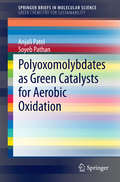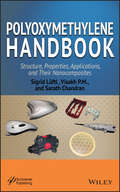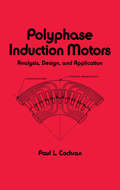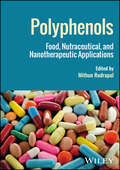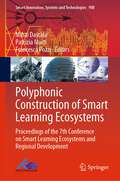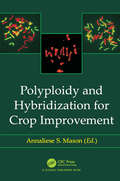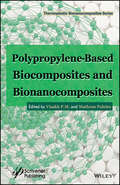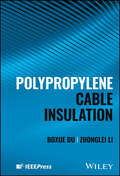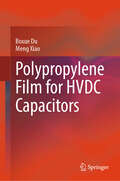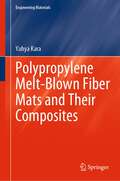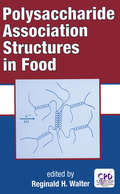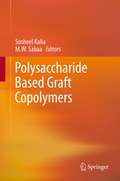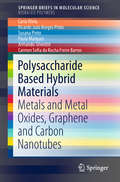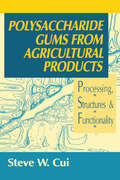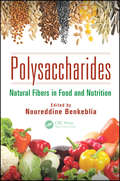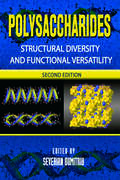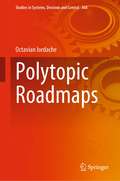- Table View
- List View
Polyoxomolybdates as Green Catalysts for Aerobic Oxidation
by Anjali Patel Soyeb PathanHeterogeneously catalyzed selective oxidations of alcohols is a highly topical field. The first chapter of this brief describes the importance of the selective oxidation of alcohols and advantages of heterogeneous catalysts over conventional catalysts, use of environmentally benign oxidants, and the design of selective catalysts by tailoring of polyoxometalates at the molecular level. Chapter 2 describes synthesis, characterization 11-molybdophosphate based supported materials and their use as heterogeneous catalysts for oxidation of alcohols with molecular oxygen under solvent free mild reaction condition. ZrO2, Al2O3, MCM-41 and zeolite Hβ were used as supports. Chapter 3 describes synthesis, characterization of transition metals (Mn, Co, Ni, Cu)- substituted phosphomolybdates and their use as heterogeneous catalysts for oxidation of alcohols with molecular oxygen under solvent free mild reaction condition. Chapter 4 describes conclusive remarks for present catalytic systems.
Polyoxymethylene Handbook
by Sarath Chandran Sigrid Lüftl Visakh P. M.In recent decades, Polyoxmethylene (POM) has been positioned as a high performance engineering polymer with increasing worldwide demand, particularly in the automotive, electronics, medical, and consumer goods industries. Despite this interest in POM, there has not been a book devoted to this compound. This volume rectifies this situation by bringing together the knowledge of leading scientists from industry and academia to present research results and applications of POM, including their structure, properties, manufacture, additives, processing and applications, as well their nanocomposites and other compounds.
Polyphagous Pests of Crops
by OmkarPolyphagous pests are primarily agricultural pests that feed on economically important agricultural and horticultural crops of wide taxonomic diversity across the globe. They cause immense damage across different crop varieties owing to their generalist and voracious food habits. The advent of mono-crop culture in a huge area and the massive use of pesticides post green revolution have massively increased pest outbreaks all over the world. The Middle Eastern countries, African continent and even the Indian subcontinent is increasingly facing resurgences of polyphagus pests. This book compiles an inclusive account of polyphagous pests. It covers locusts, termites, aphids, whiteflies, mealybugs, scale insects, gram pod borer, fall armyworm, thrips, mites and rodents. The book discusses mode of spread, enormity of losses caused, mechanism of action, and also means to reduce the crop losses. It brings together a unique perspective for researchers to learn effective pest management practices across all crops. This book is a reference guide to researchers and also useful for academicians and students of entomology.
Polyphase Induction Motors, Analysis: Design, and Application (Electrical and Computer Engineering)
by Paul CochranGenerously illustrated with over 1600 dispaly equations and more than 145 drawings, diagrams and photographs, this book is a handy, single-source reference suited to readers with a wide span of educational backgrounds and technical experience. Comprehensive in both scope and depth this manual covers all significant aspects of the field, such as Amperes Law and Faraday's Law, emphasing basic explanations of motor behaviour, derives all important equations and relationships required to analyze, design and apply polyphase induction motors, uses worldwide SI units or international MKS system of units as well as practical units used in the US and shows how to apply working equations to real-life situations with numerical examples... and more.
Polyphenols: Food, Nutraceutical, and Nanotherapeutic Applications
by Mithun RudrapalPolyphenols Understand polyphenols and their benefits with this comprehensive overview Polyphenols are a group of beneficial compounds—including phenolic acids, flavonoids, anthocyanins, and others—that can be found in a vast range of plants and plant-based foods. Their health benefits and the variety of their applications in functional foods, dietary supplements, and similar areas have made polyphenols a $1 billion market, a figure that is expected to more than double in the next decade. This has placed increased emphasis on areas of cutting-edge research such as the use of bio-based nanodelivery systems to improve the oral bioavailability of polyphenols. Polyphenols constitutes a comprehensive introduction to these compounds, their health benefits, and their potential nutraceutical applications. It incorporates both the biochemical fundamentals of polyphenols and their precise potential to prevent numerous common diseases. The result is an essential reference for a vital, growing area of research and industry. Polyphenols readers will also find: Detailed coverage of polyphenols’ occurrence, bioactivity, and technological applications In-depth discussion of nano-based delivery systems to increase polyphenols’ therapeutic efficacy and oral bioavailability and to reduce required dosages Guidance for developing treatments for cancers, cardiovascular diseases, inflammatory conditions, and more Polyphenols is ideal for food scientists and manufacturers, medicinal chemists, pharmaceutical scientists, and any biochemical or biomedical researcher or professional working with polyphenols or plant-based foods.
Polyphenols and the Mediterranean Diet (SpringerBriefs in Molecular Science)
by Amélia Martins Delgado Manel Issaoui Candela Iommi Nadia ChammemThis book focuses on polyphenols in the Mediterranean diet, providing a detailed overview of their chemical structure, extraction and analysis methods, and their role in the diet and in flavor. Phenols are important not only in terms of preventing a number of diseases due to their antimicrobial and antioxidant effects, but also in shaping our perception of foods. The first chapter discusses consumers’ sensory assessment of foods containing polyphenols in terms of flavor and color, as well as the chemical properties and natural sources of phenolic compounds. The second chapter examines hygiene and safety claims with respect to naturally occurring polyphenols, especially in connection with organoleptic features. The third and final chapter examines the dietary sources of these molecules from various fruits, including processed products such as infusions, wines, oils and olives. Given its scope, this book is a valuable resource for researchers in academia and industry interested in food safety, hygiene and production issues related to the Mediterranean diet.
Polyphonic Construction of Smart Learning Ecosystems: Proceedings of the 7th Conference on Smart Learning Ecosystems and Regional Development (Smart Innovation, Systems and Technologies #908)
by Mihai Dascalu Patrizia Marti Francesca PozziThe book brings together the contributions of the 7th International Conference on Smart Learning Ecosystems and Regional Development (SLERD 2022), which aims at promoting reflection and discussion concerning R&D work, policies, case studies, and entrepreneur experiences with a special focus on understanding the relevance of smart learning ecosystems (e.g., schools, campus, working places, informal learning contexts, etc.) for regional development and social innovation and how the effectiveness of the relation of citizens and smart ecosystems can be boosted. This forum has a special interest in understanding how technology mediated instruments can foster the citizen’s engagement with learning ecosystems and territories, namely by understanding innovative human-centric design and development models/techniques, education/training practices, informal social learning, innovative citizen-driven policies, technology mediated experiences, and their impact. This set of concerns will contribute to foster the social innovation sectors and ICT and economic development and deployment strategies alongside new policies for smarter proactive citizens.
Polyploidy and Hybridization for Crop Improvement
by Annaliese S. MasonMany of our current agricultural crops are natural or agricultural hybrids (between two or more species), or polyploids (containing more than one genome or set of chromosomes). These include potato, oats, cotton, oilseed rape, wheat, strawberries, kiwifruit, banana, seedless watermelon, triticale and many others. Polyploidy and hybridization can also be used for crop improvement: for example, to introgress disease resistance from wild species into crops, to produce seedless fruits for human consumption, or even to create entirely new crop types. Some crop genera have hundreds of years of interspecific hybridization and ploidy manipulation behind them, while in other genera use of these evolutionary processes for crop improvement is still at the theoretical stage. This book brings together stories and examples by expert researchers and breeders working in diverse crop genera, and details how polyploidy and hybridization processes have shaped our current crops, how these processes have been utilized for crop improvement in the past, and how polyploidy and interspecific hybridization can be used for crop improvement in the future.
Polypropylene-Based Biocomposites and Bionanocomposites
by Visakh P. M. Matheus PolettoThis book discusses new developments in an up-to-date, coherent and objective set of chapters by eminent researchers in the area of polypropylene-based biocomposites and bionanocomposites. It covers, biomaterials such as cellulose, chitin, starch, soy protein, hemicelluloses, polylactic acid and polyhydroxyalkanoates. Other important topics such as hybrid biocomposites and bionanocomposites of polypropylene, biodegradation study of polypropylene-based biocomposites and bionanocomposites, polypropylene-based bionanocomposites for packaging applications, polypropylene-based carbon nanomaterials reinforced nanocomposites, degradation and flame retardency of polypropylene-based composites and nanocomposites, are covered as well.
Polypropylene Cable Insulation
by Boxue Du Zhonglei LiAn introduction to a cutting-edge, environmentally friendly insulation material The installation and maintenance of high-voltage cables is an infrastructure problem with potentially major environmental impacts. In recent years, polypropylene has emerged as an environmentally friendly material for insulating high-voltage cables, particularly HVDC power cables and HVAC power cables. Polypropylene Cable Insulation begins with an introduction to high-voltage cables and the development of polypropylene insulation before describing the dielectric properties and applications of this insulation in both HVDC and HVAC contexts. The result is a thorough, accessible guide to an essential part of any environmentally friendly power grid. Readers will also find: Detailed explorations of the relationship between space charge behaviors and trap characteristics Discussion of topics including polarization and dielectric relaxation, electrical treeing degradation, partial discharge, and more Graphs and tables illustrating experimental results Polypropylene Cable Insulation is ideal for electrical power engineers, power transmission system operators, and any engineers or researchers working in power transmission and/or distribution cables.
Polypropylene Film for HVDC Capacitors
by Boxue Du Meng XiaoPolypropylene film is the most widely used dielectric material in HVDC capacitors. As the voltage level and transmission capacity of the power system increase, the dielectric properties of polypropylene film become more demanding. In recent years, researchers have studied the modification methods of polypropylene film to improve its breakdown field strength and energy storage density under operating conditions, and to reduce its dielectric loss. This book comprehensively reports the relevant research on polypropylene film for HVDC capacitors. The book details the application background, fundamental properties and related theories of polypropylene dielectrics. The relationship between the microstructure and the dielectric properties of polypropylene films is described, and the insulation failure mechanism of polypropylene is discussed. The modification methods of polypropylene energy storage media including ash washing, molecular chain structure regulation, aggregation structure regulation, nanoparticle doping, polyphenyl ring compound modification, cycloolefin copolymer blending and interfacial molecular regulation are reviewed. The effects of high temperature and strong magnetic field on the dielectric properties of polypropylene films are discussed and the high temperature and strong magnetic field resistant polypropylene dielectrics are presented.The book contains the dielectric constant, conductivity, breakdown field strength, energy storage density and other relevant graphs and data of modified polypropylene film under different operating conditions, which clearly explains the improvement effect of various modification methods on the dielectric properties of polypropylene film. This book provides a comprehensive reference for the research of polypropylene film for HVDC capacitors. It can help students, researchers and technicians in related industries to understand the insulation failure mechanism of polypropylene film and make readers understand the latest modification methods to improve the dielectric performance of PP films.
Polypropylene Melt-Blown Fiber Mats and Their Composites (Engineering Materials)
by Yahya KaraThis book provides critical insights into the properties and applications of melt-blown fibers in the polymer composite field. The book offers a comprehensive overview of the melt-blowing process and explores the intricate structure-property-parameter relationship of melt-blown fibers. In addition, the book presents a straightforward method for manufacturing multiscale Polypropylene single-polymer composites and carbon-nanotube-doped Polypropylene melt-blown fibers.
Polysaccharide Association Structures in Food (ISSN)
by Reginald H. WalterFocuses on the physical-chemical origins and structures formed by the association of aqueous, dispersed polysaccharides with related and unrelated chemical species. Covers the origin of polysaccharide supramolecular assemblies; polysaccharide molecular structures; gel formation and ultrastructure in food polysaccharides; structures and phase transitions of starch polymers; microcrystalline cellulose technology; cyclodextrins; starch-lipid interactions; interactions in whey protein/polysaccharide mixtures; and more.
Polysaccharide-based Fibers and Composites
by Lucian Lucia Ali AyoubThis book includes chapters based on the potential uses of polysaccharides such as fibers in food and non-food applications. The complexity of their synthesis in plants, the highly multidisciplinary character of polysaccharide research, and the wide variety of applications from food to clothing to energy are addressed in this volume. The authors describe in detail how these latter grand challenges are of great importance in research, especially in the midst of enormous overpopulation and economic issues. Therefore, the volume contributes additional information to the chemical, nutritional, medical, and energy roles of these bio-based products, finding applications in diverse fields of their raw and composite forms. This volume is a useful resource for graduate students and contains themes for instructors and senior research leaders. Written by internationally renowned experts, it is aimed at workers in polymer laboratories, classrooms, and policy makers.
Polysaccharide Based Films for Food Packaging: Fundamentals, Properties and Applications
by Syed Zameer Hussain Tawheed Amin Sajad Mohd Wani H. R. NaikThis book offers an extensive overview of the current and future potential of polysaccharides-based films, providing in-depth coverage of the fundamentals and basics of polysaccharide-based films.Aimed at students, scholars, scientists, and food packaging professionals, this book delves into the properties and applications of polysaccharide-based edible films in the food packaging industry. It provides insights and pathways for widening the applications of polysaccharide-based films to maximize their benefits in various industries and research institutes worldwide. With a wealth of scientific knowledge presented in an organized manner, this book serves as a valuable reference for researchers and professionals in food and pharmaceutical industries, as well as those in research and development (R&D) institutes.
Polysaccharide Based Graft Copolymers
by Susheel Kalia M. W. SabaaRenowned experts give all essential aspects of the techniques and applications of graft copolymers based on polysaccharides. Polysaccharides are the most abundant natural organic materials and polysaccharide based graft copolymers are of great importance and widely used in various fields. Natural polysaccharides have recently received more attention due to their advantages over synthetic polymers by being non-toxic, biodegradable and available at low cost. Modification of polysaccharides through graft copolymerization improves the properties of polysaccharides. Grafting is known to improve the characteristic properties of the backbones. Such properties include water repellency, thermal stability, flame resistance, dye-ability and resistance towards acid-base attack and abrasion. Polysaccharides and their graft copolymers find extensive applications in diversified fields. Applications of modified polysaccharides include drug delivery devices, controlled release of fungicides, selective water absorption from oil-water emulsions, purification of water etc.
Polysaccharide Based Hybrid Materials: Metals and Metal Oxides, Graphene and Carbon Nanotubes (SpringerBriefs in Molecular Science)
by Carla Vilela Ricardo João Pinto Susana Pinto Paula Marques Armando Silvestre Carmen Sofia da Rocha Freire BarrosThis brief explores polysaccharides, the most abundant family of naturally occurring polymers, and explains how they have gained considerable attention in recent decades as a source of innovative bio-based materials. The authors present a range of material including an extensive array of polysaccharide hybrid nanomaterials with distinct applications. The most recent knowledge regarding polysaccharide-based hybrid nanomaterials with metal and metal oxide nanoparticles (NPs), carbon nanotubes and graphene is presented as well as the main polysaccharides, namely cellulose, chitin and chitosan, starch and their most relevant derivatives. The book features a description of important production methodologies, properties, and applications of these types of hybrids.
Polysaccharide-Based Nanocrystals: Chemistry and Applications
by Jin Huang Peter R. Chang Ning Lin Alain DufresnePolysaccharide nanocrystals, an emerging green nanoingredient (nanomaterial) with high crystallinity obtained by acid hydrolysis of biomass-based polysaccharides, are of scientific and economic significance owing to their abundance, biodegradation potential, and fascinating functional performance. This versatile class of materials can be used in nanocomposites such as rubber or polyester, and in functional materials such as drug carriers, bio-inspired mechanically adaptive materials or membranes, to name but a few. This book encompasses the extraction, structure, properties, surface modification, theory, and mechanism of diverse functional systems derived from polysaccharide nanocrystals. This highly sought-after trendy book is currently the only monograph devoted to the most current knowledge pertaining to this exciting subject area. It is ideal for researchers and stakeholders who wish to broaden and deepen their knowledge in the fast-moving and rapidly expanding R&D field of polymeric materials.
Polysaccharide Building Blocks
by Youssef Habibi Lucian A. LuciaThis book is an archival reference for the evolving field of biomaterials and their applications in society, focusing on their composition, properties, characterization, chemistry and applications in bioenergy, chemicals, and novel materials and biomaterials. It has broad appeal due to the recent heightened awareness around bioenergy and biomass as potential replacements for petroleum feedstocks. The book is divided into three parts: cellulose-based biomaterials, chitin and chitosan biomaterials, and hemicelluloses and other polysaccharides. Each chapter addresses a separate biomaterial, discussing its chemical, physical, and biological attributes, and hones in on each compound's intrinsic tunability for numerous chemical transformations. In the current quest for a "green" economy and resources, this book will help inspire scientists towards novel sources for chemicals, materials, and energy in the years to come.
Polysaccharide Gums from Agricultural Products: Processing, Structures and Functionality
by Steve W. CuiThis new reference presents the most recent information on new and potential food hydrocolloids originated from agricultural products, including o yellow mustard gum o flaxseed gum o cereals (wheat, barley, oat, and corn)o psyllium fenugreek o soybean. Polysaccharide Gums from Agricultural Products: Processing, Structures and Functionality addresse
Polysaccharides: Natural Fibers in Food and Nutrition
by Noureddine BenkebliaThis book reviews the evidence supporting the influence of plant fibers on our daily life by either having impacts on our nutrition or improving processed foods for human and animal feeding. By bringing new information and updating existing scientific data, this book will also be a consistent source of information for both professional and non-prof
Polysaccharides: Structural Diversity and Functional Versatility, Second Edition
by Severian DumitriuCompletely revised and expanded to reflect the latest advancements in the field, Polysaccharides: Structural Diversity and Functional Versatility, Second Edition outlines fundamental concepts in the structure, function, chemistry, and stability of polysaccharides and reveals new analytical techniques and applications currently impacting the cosmeti
Polysaccharides: Properties and Applications
by Inamuddin Mohd Imran Ahamed Rajender Boddula Tariq AltalhiThis book provides the whole spectrum of polysaccharides from basic concepts to commercial market applications. Chapters cover various types of sources, classification, properties, characterization, processing, rheology and fabrication of polysaccharide-based materials and their composites and gels. The applications of polysaccharides include in cosmetics, food science, drug delivery, biomedicine, biofuel production, marine, packaging, chromatography and environmental remediation. It also reviews the fabrication of inorganic and carbon nanomaterials from polysaccharides. The book incorporates industrial applications and will fill the gap between the exploration works in the laboratory and viable applications in related ventures.
Polysaccharides of Microbial Origin: Biomedical Applications
by Rui L. Reis Joaquim Miguel Oliveira Hajer RadhouaniThis book provides a comprehensive analysis of microbial polysaccharides, their current uses, and highlights biomedical opportunities. The topics comprise principally a) their extraction, isolation, purification and advanced production processes; b) characterization of their structural, physicochemical, and biological properties, among others, by several techniques; c) description of the advanced functionalization and modification methods for the polysaccharide based-material; and d) their applications and uses in medical and pharmaceutical fields. Each chapter is written by world-renowned academics and practitioners on their field. This is an essential reference for students in biomedical, chemical, material, and microbiology engineering as well as researchers and professionals in the medical field.
Polytopic Roadmaps (Studies in Systems, Decision and Control #368)
by Octavian IordacheThis book is useful to engineers, researchers, entrepreneurs, and students in different branches of production, engineering, and systems sciences. The polytopic roadmaps are the guidelines inspired by the development stages of cognitive-intelligent systems, and expected to become powerful instruments releasing an abundance of new capabilities and structures for complex engineering systems implementation. The 4D approach developed in previous monographs and correlated with industry 4.0and Fourth Industrial Revolution is continued here toward higher dimensions approaches correlated with polytopic operations, equipment, technologies, industries, and societies. Methodology emphasizes the role of doubling, iteration, dimensionality, and cyclicality around the center, of periodic tables and of conservative and exploratory strategies. Partitions, permutations, classifications, and complexification, as polytopic chemistry, are the elementary operations analyzed. Multi-scale transfer, cyclic operations, conveyors, and assembly lines are the practical examples of operations and equipment. Polytopic flow sheets, online analytical processing, polytopic engineering designs, and reality-inspired engineering are presented. Innovative concepts such as Industry 5.0, polytopic industry, Society 5.0, polytopic society, cyber physical social systems, industrial Internet, and digital twins have been discussed. The general polytopic roadmaps, (GPTR), are proposed as universal guidelines and as common methodologies to synthesize the systemic thinking and capabilities for growing complexity projects implementation.
